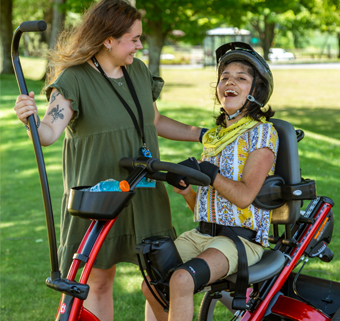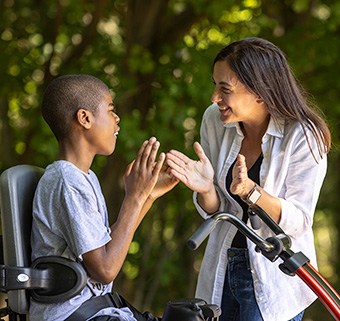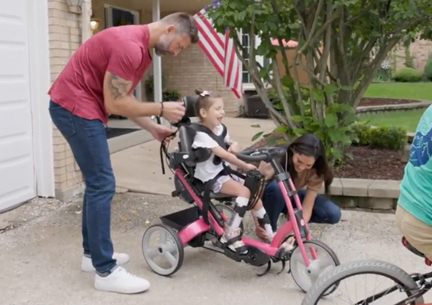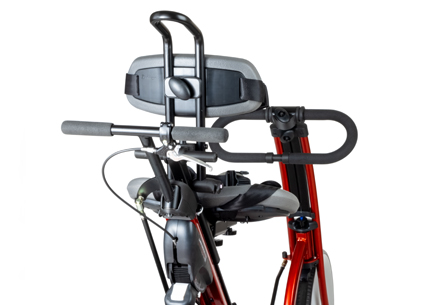 Recall the days of your childhood… hair streaming out behind, wobbling down a hill at what you thought was break–neck speed, pedaling like fury or lifting your feet up to let the pedals churn below, swerving just in time to miss an elderly pedestrian and ending up in a ditch in fits of laughter alongside your friends — just the thrill of it — that is the tricycle.
Recall the days of your childhood… hair streaming out behind, wobbling down a hill at what you thought was break–neck speed, pedaling like fury or lifting your feet up to let the pedals churn below, swerving just in time to miss an elderly pedestrian and ending up in a ditch in fits of laughter alongside your friends — just the thrill of it — that is the tricycle.
Of course a tricycle is fun, and many of us used it as a stepping stone to the more sophisticated bicycle, but to those with physical disabilities, the adaptive tricycle has therapeutic value as well as recreational value. An adaptive tricycle can be medically necessary for those who do not have the physical ability to walk independently or who sit for long hours in a wheelchair.
In the educational setting, children or young adults with disabilities will receive therapy and work towards goals such as improving lower extremity ROM, gait and increasing functional strength. But therapy once or even twice a week is not enough to achieve these goals. Motor learning and skill building are a result of hours of practice opportunities.
That is when an adaptive tricycle becomes a medically necessary piece of equipment. Use of the adaptive tricycle can improve balance, coordination and strength in children with disabilities. In children with cerebral palsy, studies show the generalization of these skills into further functional mobility. Steering exercises, uphill pedaling, stopping and starting, backing up, and safety awareness, can be incorporated into practice sessions for further challenge.
By riding an adaptive tricycle outside of therapy, at home or in school, a child is being provided with increased opportunities to build on and achieve the skills introduced in formal therapy. This will ultimately lead to increased independence. Of course, a child will never see it as such since riding an adaptive tricycle is fun and allows for more peer interaction. Indeed, others may need educating on this point to understand the full benefits of adaptive tricycle use beyond recreation for people with disabilities. That is why, when seeking reimbursement from insurance companies, it is best to refer to the adaptive tricycle as a therapeutic mobility device, to relay the value it can bring to the life and health of an individual with disability.
Adult supervision of the user is necessary at all times to assure safe use of this product.
The following article outlines the specific features and accessories of the Rifton adaptive Tricycle:
Tricycle Features
Sizes and colors
The Rifton Tricycle is available in three sizes: Small (R120) (formerly Rustler), Medium (R130) (formerly Ranger), and Large (R140) (formerly Wrangler). The Small Tricycle serves children up to 150lbs in weight, the Medium up to 160lbs, and the Large up to 200lbs. The measurement of the student’s inside leg length, as compared to the distance from the seat center to the extended foot pedal, is the most effective way to determine which tricycle is the appropriate size. The adjustability of seat height and overall tricycle size range assures that a child will always have a tricycle to ride, as they grow older and larger. Rifton Tricycles are currently available in Lime Green, Red, and Blue.
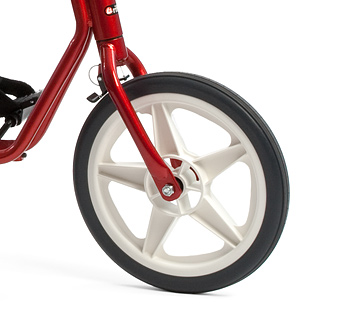
|
Wheels
The large, puncture-proof BMX-type wheels ride easily on indoor surfaces or outdoor pavement. A hidden stop prevents over-steering of the front wheel. The steering function is separate from pedaling, making it easier for an early learner to maneuver the trike. A low gear ratio makes pedaling easier for beginners; this feature also slows down speeders! The drive chain is enclosed for safety. The wide wheelbase adds stability, yet the largest size fits through a standard 32" doorway for ease of indoor mobility.
|
|
|
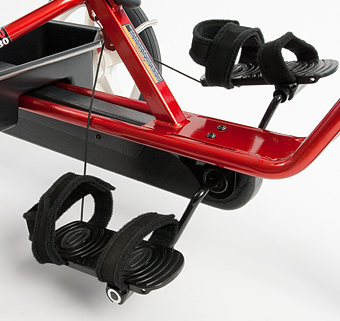
|
Self leveling pedals
The pulley system, attached at the back end of each pedal, keeps the pedals level as the child actively propels the trike. For children whose extreme tone forces the front of the pedal downward, an optional Front Pulley system is available. Hook and loop straps keep the user’s feet securely in place.
|
|
|
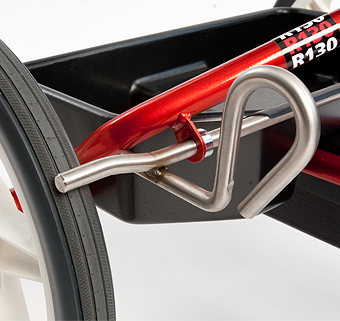
|
Low Transfer Step and Parking Brake
The low transfer step and open access allows safe mounting on and off the Rifton Tricycle, and easy access for the caregiver.
The parking brake at the rear wheels is engaged and disengaged quickly and easily to assure safety.
|
|
|

|
Storage Tray
The snap-out storage tray between the rear wheels is easily reached for transporting items, and can be removed for cleaning.
|
|
|
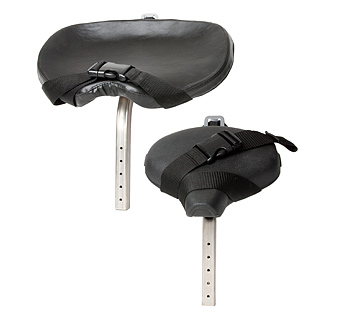
|
Seat and Seatbelt
Tricycle seats are upholstered for comfort, and come with an adjustable seat belt. There are two seat sizes available for the Small (R120, formerly Rustler) and Medium (R130, formerly Ranger) models: Small (10" wide, 10" long) and Large (16" wide, 12" long). The Large Tricycle (R140, formerly Wrangler) will come with the large seat.
|
|
|
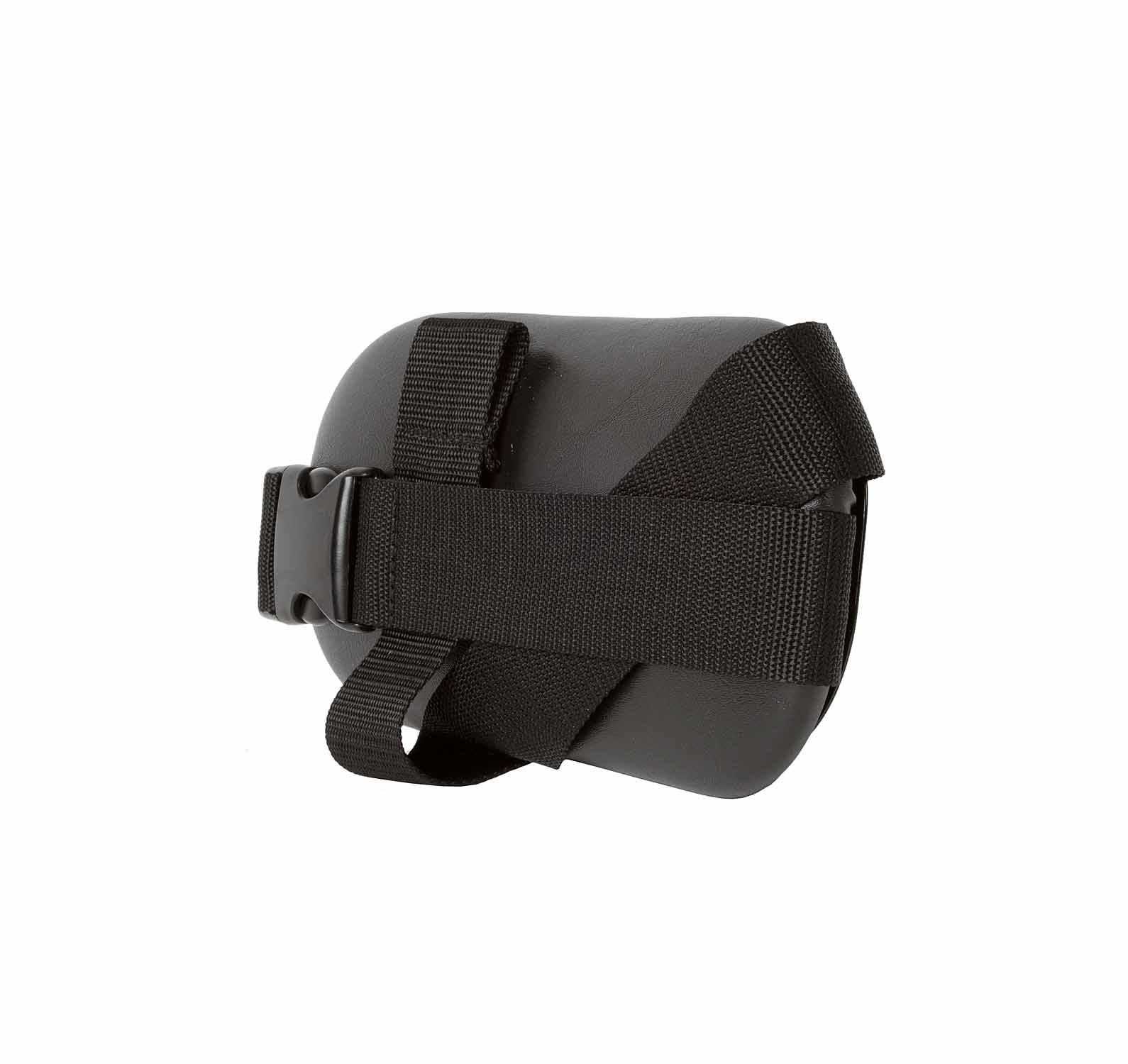
|
Backrest and Backrest Pad
The backrest frame itself can be moved farther forward or farther back from the seat, by loosening and tightening the knob under the tricycle seat. The backrest pad can be moved up or down along the backrest frame to optimize support. The backrest pad has an adjustable strap to secure the trunk if needed. An additional backrest pad can be ordered, so that there are two backrest pads on the frame,
if desired.
|
|
|
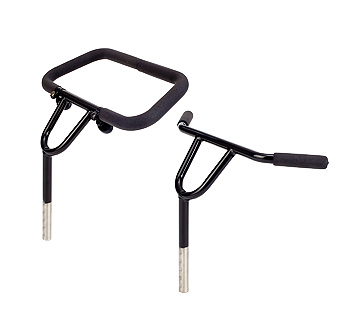
|
Handlebars
All three sizes of tricycle have the option of the conventional handlebar or the loop handlebar. The conventional handlebar has standard handgrips and is height adjustable. The loop handlebar is covered with foam, and can be positioned at any angle. In the horizontal position, it can provide forearm support for the user.
|
|
|

|
Handbrake
The handbrake comes standard on the Large tricycle (R140). The handbrake is an option for the Medium tricycle, (R130) and is factory–installed on either choice of handlebar style. On the loop handlebar, the handbrake can be mounted anywhere on the foam padded handlebar for the user.
|
Tricycle Accessories
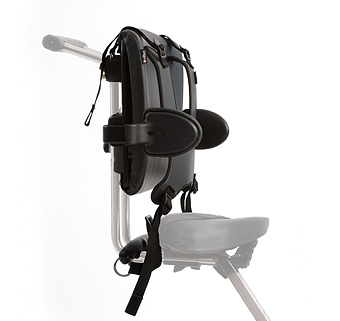
|
Trunk Support System
The trunk support system stabilizes a child that has poor balance, aiding users who have difficulty remaining upright while sitting. It can be used to correct excessive leaning forward, or leaning toward one side. The trunk support system attaches easily onto the backrest frame and is height adjustable. The butterfly harness detaches easily for transfers. The lateral supports are width adjustable and can be easily removed. The optional headrest attaches to the top of the trunk support system. If you are purchasing a trunk support system for your existing Rifton adaptive tricycle, be sure to include a new–
style backrest tube with handle in your order, as it will not retrofit onto the old–style backrest tubes.
|
|
|
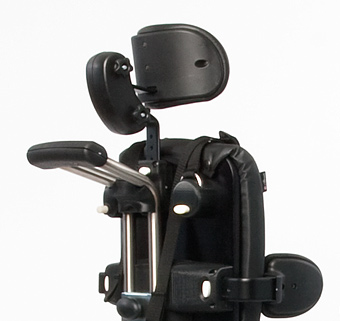
|
Headrest
Two headrests are available for use with the trunk support system only. One is flat, the other contoured. Headrests are easily adjusted for height, depth, and angle with two knobs.
|
|
|
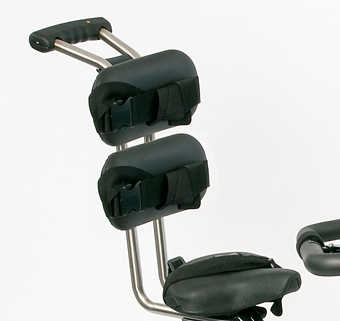
|
Additional Backrest
For a student with a tall trunk who does not need a full trunk support system, but does need to be provided with sufficient support at the trunk, it is possible to use more than one backrest pad on the backrest frame. The additional backrest pad with its adjustable strap and buckle provides additional support.
|
|
|

|
Front Pulley
The front pulley system maintains a level pedal for children whose extreme tone forces the front of the pedal downward.
|
|
|

|
Abductor
The abductor mounts easily without tools, and provides comfortable abduction if needed. The abductors for the Medium (R130) and Large (R140) tricycles are height-adjustable with a snap button.
|
|
|

|
Front Guide Bar
To assist a new rider learning movement and balance, the caregiver uses the guide bar to steer and pull the tricycle. Even when the user does not participate at all, the wheels and the pedals will move around, providing range of motion for the lower extremities. The caregiver will be in front to steer the tricycle and provide eye contact, encouragement and motivation. The front guide bar snaps into place, tool-free.
|
|
|
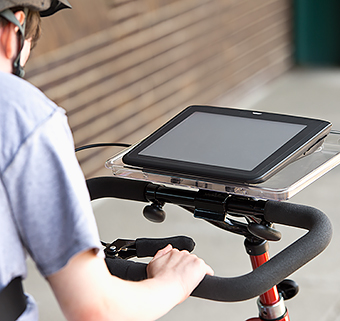
|
Communication Tray
The communication tray comes in two sizes, is easy to clean, and is designed to hold small items such as a communication device. The Large tray (11½ x 13½ inches) fits the Large trike (R140), and the Small tray (8½ x 12½ inches) fits the Small (R120) and Medium (R130) models.
|
|
|

|
Rear Steering Bar
The rear steering bar allows the caregiver to guide the tricycle from behind — ideal for riders who can’t steer themselves. The support bar attaches to the backrest tubes, and is height–adjustable. (Note: A very high support bar position may result in interference between the push rod and the tricycle handlebar in its lowest position.) The front clamp attaches to the handlebar U–tube. The rear steering bar retrofits to existing Rifton adaptive tricycles in the field.
|
|
|

|
Stationary Stand
The stationary stand converts the tricycle into a stationary trainer, for learning the basic motions of pedaling. The stand should be centered laterally on the length of the rear axle. This accessory is intended for use on Rifton Tricycles only.
|
 Recall the days of your childhood… hair streaming out behind, wobbling down a hill at what you thought was break–neck speed, pedaling like fury or lifting your feet up to let the pedals churn below, swerving just in time to miss an elderly pedestrian and ending up in a ditch in fits of laughter alongside your friends — just the thrill of it — that is the tricycle.
Recall the days of your childhood… hair streaming out behind, wobbling down a hill at what you thought was break–neck speed, pedaling like fury or lifting your feet up to let the pedals churn below, swerving just in time to miss an elderly pedestrian and ending up in a ditch in fits of laughter alongside your friends — just the thrill of it — that is the tricycle.

















